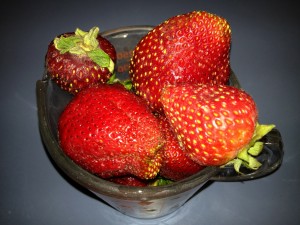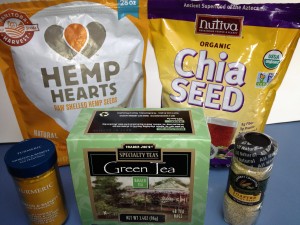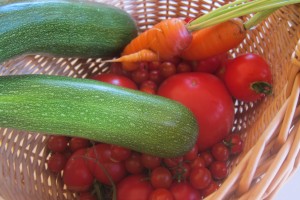Anti-Inflammatory Foods and a Guide to Help YOU Get Started
Many of the foods on the anti-inflammation list are vegetables, fruits, seeds, nuts and non-animal based foods. Anti-inflammatory foods reduce the levels of inflammation in the body. When you eat anti-inflammatory foods at each meal, you can help protect your body one meal at a time.
“All disease is rooted in chronic inflammation in the body. Diabetes and obesity are now linked with chronic inflammation. Researchers have long known heart disease and inflammation were intrinsically tied and even cancers are perpetuated by chronic inflammation. Eliminate inflammation in the body, and disease begins to improve.” says Julie Daniluk, R.H.N.
Here is my list: (the anti-inflammatory nutrient is listed when available)
VEGETABLES
Kale (Omega 3)
Spinach (magnesium, calcium, folate, Vit A,B2,B6,C,K, iron)
Broccoli (sulforaphane)
Cauliflower (sulforaphane)
Brussel sprouts (sulforaphane)
Sweet potato (beta carotene, managanese, Vit B6,C)
Shitake mushrooms
Purple cabbage
Squash (carotenoids)
Tomatoes
FRUITS
Blueberries (phytonutrients)
Strawberries (phytonutrients)
Cranberries (phytonutrients)
Blackberries (phytonutrients)
Grapes
Papaya (papain)
Pineapple (bromelain)
SPICES/SEEDS/NUTS
Tumeric (cucurumin)
Ginger
Garlic
Flax seed
Chia seed (omega 3, protein and fiber)
Sesame seeds (plant sterols, Vit B1,B3,E calcium, iron, magnesium, manganese)
Hemp seeds (plant sterols, Vit B1,B3,E, calcium, Omega 3 and 6, iron, magnesium, manganese)
Walnuts
Sprouted sunflower seeds (omega 6, potassium, magnesium, iron)
OTHERS
Wild Salmon (EPA, DHA, Omega 3)
Olive oil
Avocado oil (polyphenols)
Green Tea (flavinoids)
Kelp (fucoidan)
Dark Chocolate (antioxidants, potassium, copper, magnesium, iron)


A few of the things I am going to make a commitment to cutting down on or removing totally from my diet are as follows:
Refined sugar
Transfat
Polyunsturated fats
Hydrogenated fats (including vegetable shortening)
Feed lot meat
Processed meat
Refined grains
Food additives
Here is a guide to help you with transforming your eating habits. Take one step at a time. Change what is logical for your lifestyle. This information is key to helping establish a diet that is high in anti-inflammatory foods but it has to work for YOU in order for you to make the lifestyle changes that will become part of your routine on a regular basis.
HEALTHY HERBS & SPICES: Unlimited amounts
Healthy choices: Turmeric, curry powder, ginger and garlic (dried and fresh), chili peppers, basil, cinnamon, rosemary, thyme and many more…
VEGETABLES: 4-5 servings per day minimum
Healthy Choices: Lightly cooked dark leafy greens (spinach, collard greens, kale, Swiss chard), cruciferous vegetables (broccoli, cabbage, Brussels sprouts, kale, bok choy and cauliflower), carrots, beets, onions, peas, squashes, sea vegetables and washed raw salad greens
Why: Vegetables are rich in flavonoids and carotenoids with both antioxidant and anti-inflammatory activity. Go for a wide range of colors, eat them both raw and cooked, and choose organic when possible.
FRUITS: 3-4 servings per day
Healthy choices: Raspberries, blueberries, strawberries, peaches, nectarines, oranges, pink grapefruit, red grapes, plums, pomegranates, blackberries, cherries, apples, and pears – all lower in glycemic load than most tropical fruits
Why: Fruits are rich in flavonoids and carotenoids with both antioxidant and anti-inflammatory activity. Go for a wide range of colors, choose fruit that is fresh in season or frozen, and buy organic when possible.
WHOLE SOY FOODS: 1-2 servings per day
Healthy choices: Tofu, tempeh, edamame, soy nuts, soymilk
Why: Soy foods contain isoflavones that have antioxidant activity and are protective against cancer. Choose whole soy foods over fractionated foods like isolated soy protein powders and imitation meats made with soy isolate.
FISH & SEAFOOD: 2-6 servings per week
Healthy choices: Wild Alaskan salmon (especially sockeye), herring, sardines, and black cod (sablefish)
Why: These fish are rich in omega-3 fats, which are strongly anti-inflammatory. If you choose not to eat fish, take a molecularly distilled fish oil supplement, 2-3 grams per day.
Other Sources of PROTEIN: 1-2 servings a week
Healthy choices: Natural cheeses, organic, high-quality dairy, omega-3 enriched eggs, skinless poultry, lean meats
Why: In general, try to reduce consumption of animal foods. If you eat chicken, choose organic, cage-free chicken and remove the skin and associated fat. Use organic, high-quality dairy products moderately, especially yogurt and natural cheeses such as Emmental (Swiss), Jarlsberg and true Parmesan. If you eat eggs, choose omega-3 enriched eggs (made by feeding hens a flax-meal-enriched diet), or eggs from free-range chickens.
HEALTHY FATS: 5-7 servings per day
Healthy choices: For cooking, use extra virgin olive oil and expeller-pressed organic canola oil. Other sources of healthy fats include nuts (especially walnuts), avocados, and seeds – including hemp seeds and freshly ground flaxseed. Omega-3 fats are also found in cold water fish, omega-3 enriched eggs, and whole soy foods. High-oleic sunflower or safflower oils may also be used, as well as walnut and hazelnut oils in salads and dark roasted sesame oil as a flavoring for soups and stir-fries
Why: Healthy fats are those rich in either monounsaturated or omega-3 fats. Extra-virgin olive oil is rich in polyphenols with antioxidant activity and canola oil contains a small fraction of omega-3 fatty acids.
WHOLE & CRACKED GRAINS: 3-5 servings a day
Healthy choices: Brown rice, basmati rice, wild rice, buckwheat, groats, barley, quinoa, steel-cut oats
Why: Whole grains digest slowly, reducing frequency of spikes in blood sugar that promote inflammation. “Whole grains” means grains that are intact or in a few large pieces, not whole wheat bread or other products made from flour.
PASTA (al dente): 2-3 servings per week
Healthy choices: Organic pasta, rice noodles, bean thread noodles, and part whole wheat and buckwheat noodles like Japanese udon and soba
Why: Pasta cooked al dente (when it has “tooth” to it) has a lower glycemic index than fully-cooked pasta. Low-glycemic-load carbohydrates should be the bulk of your carbohydrate intake to help minimize spikes in blood glucose levels.
BEANS & LEGUMES: 1-2 servings per day
Healthy choices: Beans like Anasazi, adzuki and black, as well as chickpeas, black-eyed peas and lentils
Why: Beans are rich in folic acid, magnesium, potassium and soluble fiber. They are a low-glycemic-load food. Eat them well-cooked either whole or pureed into spreads like hummus.
SUPPLEMENTS: Daily
Healthy choices: High qualitymultivitamin/multimineral that includes key antioxidants (vitamin C, vitamin E, mixed carotenoids, and selenium); co-enzyme Q10; 2-3 grams of a molecularly distilled fish oil; 2,000 IU of vitamin D3
WATER: Throughout the day
Healthy choices: Use purified water or beverages made with purified water, such as unsweetened tea, sparkling water, or water with a small amount of fruit juice for flavor
Why: Water is vital for overall functioning of the body.
HEALTHY SWEETS: Sparingly
Healthy choices: Unsweetened dried fruit, dark chocolate, fruit sorbet
Why: Dark chocolate provides polyphenols with antioxidant activity. Choose dark chocolate with at least 70 percent pure cocoa and have an ounce a few times a week.
TEA: 2-4 cups per day
Healthy choices: White, green, oolong teas
Why: Tea is rich in catechins, antioxidant compounds that reduce inflammation. Purchase high-quality tea and learn how to correctly brew it for maximum taste and health benefits.
What is one thing you can do in your life to improve your physical health?